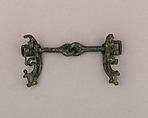Snaffle Bit
The snaffle bit is the simplest type of horse bit, and has an effect on the bars (part of the horses’ jaw without teeth) and the corners of the lips. The mouthpiece of this bit consists of two articulated straight canons passing through the eyelets of the cheekpieces. The latter, crescent-shaped, is decorated with an abstract geometrical pierced decoration forming two square loops at each point of the crescent (one is broken off on both cheekpieces), used for hanging it on the bridle. The reins would hang from the square rings attached to each side of the mouthpiece. When they were pulled, the cheekpieces would compress the corners of the lips, forcing the horse to stop. They would also help indicate the direction to the horse and keep the rings from pulling through the mouth.
Horses had a great value among Villanovan and Etruscan societies. They were used for military and leisure purposes, and possessing them was an indicator of high social status. Equestrian objects, like bridles or even chariots, were often deposited in the tombs of the wealthy individuals, the deceased hoping to equip their steeds in the afterlife. Horses are also widely present among the paintings, ceramics and other decorated objects found in the same burials.
This type is very close to bits found in the Villanovan burials of Bologna, a possible origin for this object.
This image cannot be enlarged, viewed at full screen, or downloaded.

